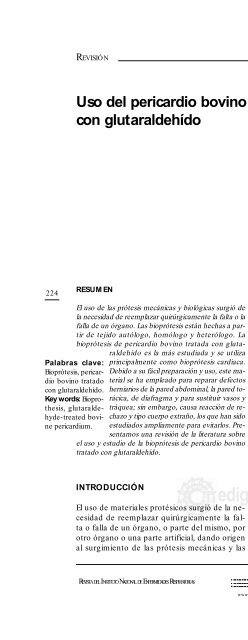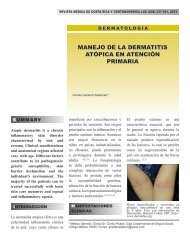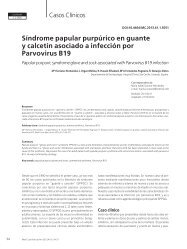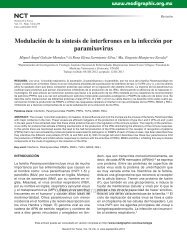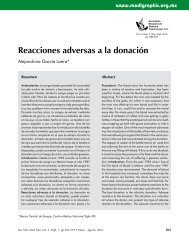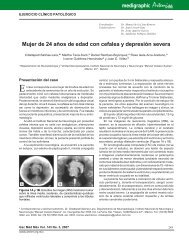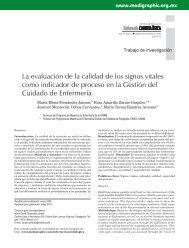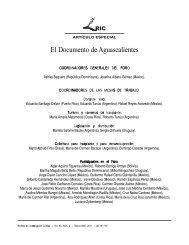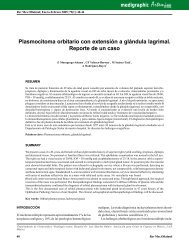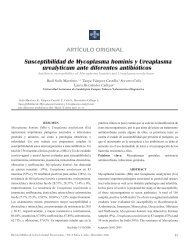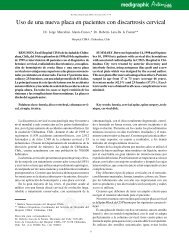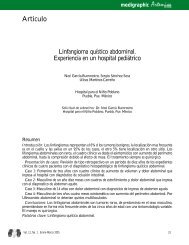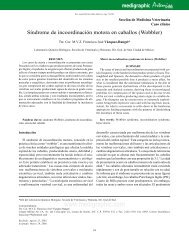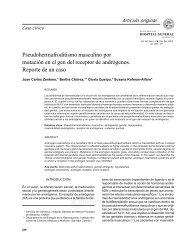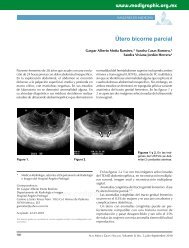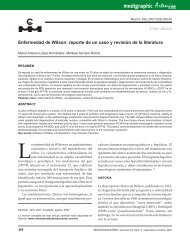Uso del pericardio bovino tratado con glutaraldehído - edigraphic.com
Uso del pericardio bovino tratado con glutaraldehído - edigraphic.com
Uso del pericardio bovino tratado con glutaraldehído - edigraphic.com
You also want an ePaper? Increase the reach of your titles
YUMPU automatically turns print PDFs into web optimized ePapers that Google loves.
224<br />
REVISIÓN<br />
<strong>Uso</strong> <strong>del</strong> <strong>pericardio</strong> <strong>bovino</strong> <strong>tratado</strong><br />
<strong>con</strong> <strong>glutaraldehído</strong><br />
RESUMEN<br />
El uso de las prótesis mecánicas y biológicas surgió de<br />
la necesidad de reemplazar quirúrgicamente la falta o la<br />
falla de un órgano. Las bioprótesis están hechas a partir<br />
de tejido autólogo, homólogo y heterólogo. La<br />
bioprótesis de <strong>pericardio</strong> <strong>bovino</strong> tratada <strong>con</strong> gluta-<br />
raldehído es la más estudiada y se utiliza<br />
principalmente <strong>com</strong>o bioprótesis cardiaca.<br />
Debido a su fácil preparación y uso, este material<br />
se ha empleado para reparar defectos<br />
herniarios de la pared abdominal, la pared torácica,<br />
de diafragma y para sustituir vasos y<br />
tráquea; sin embargo, causa reacción de rechazo<br />
y tipo cuerpo extraño, los que han sido<br />
estudiados ampliamente para evitarlos. Presentamos<br />
una revisión de la literatura sobre<br />
el uso y estudio de la bioprótesis de <strong>pericardio</strong> <strong>bovino</strong><br />
<strong>tratado</strong> <strong>con</strong> <strong>glutaraldehído</strong>.<br />
Palabras clave:<br />
Bioprótesis, <strong>pericardio</strong><br />
<strong>bovino</strong> <strong>tratado</strong><br />
<strong>con</strong> <strong>glutaraldehído</strong>.<br />
Key words: Bioprothesis,glutaraldehyde-treatedbovine<br />
pericardium.<br />
INTRODUCCIÓN<br />
El uso de materiales protésicos surgió de la necesidad<br />
de reemplazar quirúrgicamente la falta<br />
o falla de un órgano, o parte <strong>del</strong> mismo, por<br />
otro órgano o una parte artificial, dando origen<br />
al surgimiento de las prótesis mecánicas y las<br />
<strong>edigraphic</strong>.<strong>com</strong><br />
REVISTA DEL INSTITUTO NACIONAL DE ENFERMEDADES RESPIRATORIAS Julio-Septiembre 2005, Segunda Época, Vol. 18 N o 3<br />
www.iner.gob.mx<br />
DIANA PÉREZ COVARRUBIAS*<br />
AVELINA SOTRES VEGA ‡<br />
ROGELIO JASSO VICTORIA ‡<br />
J. RAÚL OLMOS ZÚÑIGA ‡<br />
JAIME VILLALBA CALOCA ‡<br />
J. ALFREDO SANTIBÁÑEZ SALGADO ‡<br />
PATRICIO SANTILLÁN DOHERTY §<br />
REV INST NAL ENF RESP MEX<br />
VOLUMEN 18 - NÚMERO 3<br />
JULIO-SEPTIEMBRE 2005<br />
PÁGINAS: 224-229<br />
* Facultad de Medicina Veterinaria y Zootecnia, UNAM.<br />
‡ Departamento de Cirugía Experimental. Unidad de Investigación,<br />
INER.<br />
§ Departamento de Cirugía Experimental. INCMNSZ.<br />
Trabajo recibido: 17-II-2005; aceptado: 21-VII-2005<br />
ABSTRACT<br />
The use of biological and mechanical prostheses arose<br />
from the need to replace a failing organ or function.<br />
Bioprostheses can be manufactured from autologous,<br />
homologus or heterologus tissue; glutaraldehyde<br />
treated bovine pericardium bioprostheses have been<br />
used extensively to repair diaphragmatic, abdominal<br />
and chest wall defects and to replace heart valves,<br />
blood vessels and tracheal segments, but the implanted<br />
tissue can elicit rejection or foreign body reaction;<br />
these have been extensively studied in order to avoid<br />
them. We review the literature regarding glutaraldehyde<br />
treated bovine pericardium bioprostheses.<br />
bioprótesis. Las prótesis mecánicas en su gran<br />
mayoría son de materiales duros y resistentes<br />
<strong>com</strong>o el acero, oro, platino, porcelana; las de<br />
tipo sintético están hechas a base de plástico,<br />
vidrio, carbono y polímeros. Las bioprótesis<br />
pueden ser de tejidos autólogos, homólogos y<br />
heterólogos.


